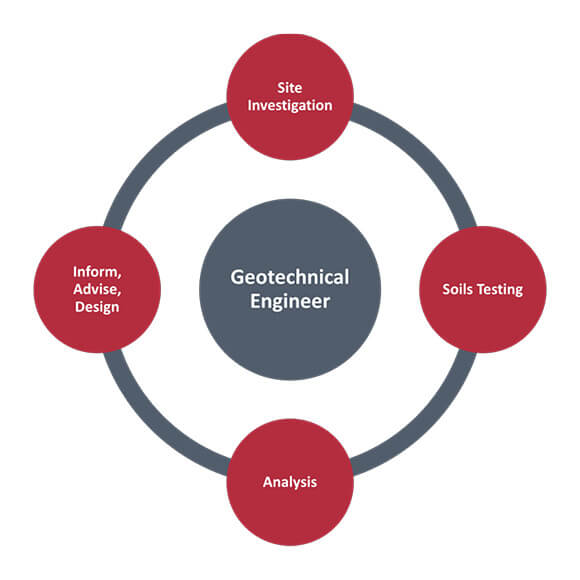The 8-Second Trick For Geotheta
The 8-Second Trick For Geotheta
Blog Article
The 20-Second Trick For Geotheta
Table of ContentsGeotheta Can Be Fun For EveryoneWhat Does Geotheta Mean?The Greatest Guide To GeothetaThings about GeothetaHow Geotheta can Save You Time, Stress, and Money.

They conduct site investigations, collect examples, perform lab tests, and evaluate information to examine the suitability of the ground for construction projects - Consulting Engineer. Based on their findings, geotechnical designers provide referrals for structure style, slope security, retaining structures, and reduction of geotechnical threats. They team up with various other experts, such as designers, structural engineers, and building groups, to guarantee that geotechnical considerations are incorporated right into the general task style and application
By evaluating the behavior and homes of dirt and rock, they can determine prospective geotechnical threats such as landslides, dirt settlement, or incline instability. Their knowledge aids avoid failures or mishaps that might jeopardize lives and property. Here are some comprehensive obligations and obligations of a geotechnical designer: Site Investigation: Geotechnical designers conduct website investigations to collect data on subsurface problems.
They analyze the data to comprehend the properties and habits of the dirt and rock, including their strength, permeability, compaction qualities, and groundwater problems. Geotechnical Analysis and Layout: Geotechnical designers evaluate the information accumulated throughout website investigations to evaluate the stability and suitability of the site for building tasks. They perform geotechnical calculations and modeling to review aspects such as birthing capacity, settlement, slope stability, lateral earth pressures, and groundwater flow.
The Definitive Guide to Geotheta
Foundation Layout: Geotechnical engineers play an essential duty in making foundations that can securely sustain the designated structure. They analyze the dirt problems and load requirements to establish the suitable foundation type, such as superficial foundations (e.g., footings), deep foundations (e.g (https://geotheta.weebly.com/)., piles), or specialized strategies like soil improvement. They take into consideration elements such as negotiation restrictions, birthing capability, and soil-structure communication to create ideal foundation styles
They assess building strategies, display website tasks, and carry out area evaluations to validate that the style recommendations are complied with. If unanticipated geotechnical concerns occur, they examine the situation and provide recommendations for remediation or modifications to the layout. Threat Evaluation and Mitigation: Geotechnical designers examine geotechnical risks and threats associated with the task website, such as landslides, liquefaction, or soil disintegration.

Cooperation and Communication: Geotechnical designers function carefully with other experts involved in a task, such as engineers, architectural designers, and building teams. Efficient communication and partnership are important to incorporate geotechnical factors to consider into the overall task design and construction process. Geotechnical designers give technological experience, solution queries, and ensure that geotechnical needs are satisfied.
How Geotheta can Save You Time, Stress, and Money.
Below are some types of geotechnical designers: Structure Engineer: Foundation designers concentrate on creating and examining foundations for frameworks. They assess the soil conditions, lots requirements, and website qualities to establish one of the most suitable structure kind and style, such as superficial structures, deep structures, or specialized techniques like heap structures.
They assess the aspects influencing slope security, such as soil buildings, groundwater problems, and incline geometry, and develop strategies to avoid slope failures and alleviate risks. Quake Engineer: Quake engineers concentrate on evaluating and making structures to withstand seismic forces. They analyze the seismic danger of a website, evaluate soil liquefaction possibility, and create seismic layout standards to make sure the safety and security and durability of frameworks throughout earthquakes.
They perform field screening, collect samples, and examine the collected data to identify the soil properties, geologic formations, and groundwater problems at a website. Geotechnical Instrumentation Designer: Geotechnical instrumentation designers concentrate on tracking and gauging the behavior of dirt, rock, and structures. They install and maintain instrumentation systems that monitor elements such as soil settlement, groundwater levels, incline movements, and structural displacements to examine efficiency and offer very early cautions of prospective concerns.
Some Known Details About Geotheta
They carry browse around these guys out examinations such as triaxial examinations, loan consolidation tests, straight shear examinations, and leaks in the structure examinations to gather data for geotechnical evaluation and style. Geosynthetics Engineer: Geosynthetics designers specialize in the layout and application of geosynthetic products, such as geotextiles, geogrids, and geomembranes. They use these materials to boost dirt stability, strengthen inclines, offer drainage remedies, and control erosion.
They have a tendency to be investigative individuals, which implies they're intellectual, introspective, and inquisitive. They are interested, methodical, sensible, logical, and sensible. Some of them are likewise social, indicating they're kind, generous, cooperative, individual, caring, valuable, understanding, tactful, and friendly - Consulting Engineer.
In the workplace environment, geotechnical engineers make use of specialized software application devices to carry out computations, create designs, and evaluate data. They prepare records, testimonial project specs, communicate with clients and team participants, and coordinate job activities. The workplace setting offers a favorable environment for research, evaluation, and cooperation with other professionals entailed in the project.
The Only Guide for Geotheta
They frequently check out project sites to carry out website investigations, assess geotechnical problems, and gather information for evaluation. These brows through involve traveling to different locations, occasionally in remote or difficult terrains. Geotechnical designers might execute soil sampling, conduct examinations, and display construction tasks to guarantee that the geotechnical elements of the task are being executed correctly.
Geotechnical designers likewise operate in specialized geotechnical laboratories. In these facilities, they perform experiments, do tests on soil and rock samples, and evaluate the engineering properties of the materials. Geotechnical lab engineers function extensively in these atmospheres, taking care of screening equipment, running tools, and tape-recording data. They team up with other lab personnel to make certain precise and trusted testing results.
Report this page